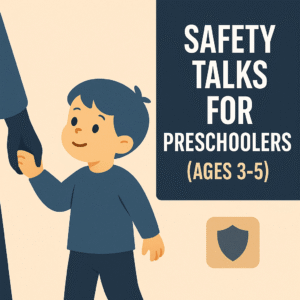
How to Talk to Preschoolers About Safety (Ages 3–5) Without Causing Fear
Preschoolers live in a world filled with imagination, curiosity, and rapid learning. They’re old enough to understand basic rules but too young to grasp abstract dangers. This makes ages 3–5 a critical window for introducing simple, positive safety lessons.
At The Security Playbook, Coach Cover is here to guide parents through trauma-informed, psychologically sound strategies for talking to preschoolers about safety — without overwhelming them.
Why Safety Conversations Start Early
-
Children overhear more than you think. Even at age three, kids pick up on adult conversations, TV news, or scary stories from siblings.
-
Habits form early. Preschoolers learn routines (like washing hands) quickly. Safety routines become second nature if started now.
-
Confidence reduces anxiety. Research shows children who practice basic safety feel less afraid when real situations happen.
Psychological Principles for Ages 3–5
Preschoolers:
-
Think in concrete, literal terms (“A stranger is anyone I don’t know.”).
-
Have short attention spans — lessons need to be quick and repeated often.
-
Rely heavily on modeling — they do what you do, not just what you say.
-
Respond best to positive reinforcement over fear-based warnings.
Trauma-Informed Approach:
-
Keep conversations calm and matter-of-fact.
-
Validate feelings (“It’s okay to feel scared if you can’t see me in a store”).
-
Use simple choices and role-play rather than lectures.
Key Safety Topics for Preschoolers
🧸 1. Identifying Safe Adults
Teach your child that safe adults include parents, teachers, police officers, or other trusted caregivers.
-
Keep a short list of “safe grown-ups.”
-
Practice: “Who can you go to if you need help?”
Pro Tip: Show them pictures of community helpers (police, firefighters, store clerks with nametags). Kids this age learn visually.
🛒 2. What to Do If They Get Lost
Preschoolers’ biggest real-world risk isn’t crime — it’s separation in crowded places.
-
Teach them: “Stop, stay in one place, and look for a safe adult.”
-
Role-play at home: Pretend you’re at the grocery store and you can’t see each other.
Scenario: Your child wanders down a toy aisle. Instead of panicking, they remember to stand still and find a store clerk.
🧑🤝🧑 3. The “Stay With Me” Rule
Kids this age love to dart away. Create a family rule: always hold hands or stay within arm’s reach in public.
-
Turn it into a game: “Can you be my walking buddy?”
-
Reinforce positively when they follow the rule.
🚫 4. Basics of “Stranger Danger” (Without Fear)
Traditional “stranger danger” can scare young kids, but preschoolers need a simple framework:
-
Don’t go anywhere with someone you don’t know.
-
Always check with Mom/Dad before taking candy, toys, or pets from anyone.
Pro Tip: Emphasize checking with a parent instead of just saying “Don’t talk to strangers.” That creates empowerment, not fear.
🧾 5. Knowing Their Own Info
By age 4–5, many preschoolers can learn:
-
First and last name
-
Parent’s name
-
Parent’s phone number (or at least how to say “Call my mom/dad”)
Practice: Use songs or rhymes to help them memorize.
🔥 6. Fire Safety Basics
Preschoolers can learn simple rules:
-
“Stop, Drop, and Roll.”
-
Crawl low under smoke.
-
Never hide from firefighters.
Pro Tip: Make fire drills fun practice, not scary.
How to Have the Conversations
-
Keep it Short: 2–3 minutes is plenty.
-
Repeat Often: Consistency builds memory.
-
Use Play: Dolls, stuffed animals, or role-play make lessons stick.
-
Praise Success: Celebrate when they demonstrate the rule in practice.
Sample Conversation Starters
-
“What would you do if you couldn’t find me in the store?”
-
“Who are some safe helpers you can ask if you need help?”
-
“Can you tell me our family’s safe word?”
-
“Let’s practice how we leave the house safely in a fire drill.”
Common Mistakes to Avoid
❌ Overloading with scary details. Preschoolers don’t need crime statistics.
❌ Using fear to control behavior (“If you run off, someone will take you”).
❌ Expecting one conversation to be enough.
FAQs for Parents of Preschoolers
Q: How early should I start safety talks?
👉 As early as age 3 — but keep it very simple.
Q: What if my child gets anxious?
👉 Reassure them: “These are things we practice to keep safe, just like wearing a seatbelt.”
Q: Should I use videos or cartoons to teach safety?
👉 Yes, as long as they’re positive and age-appropriate. Role-play after to reinforce.
Q: My child is shy — how do I teach them to ask for help?
👉 Practice scripts: “Excuse me, can you help me find my mom?” Build confidence through pretend play.
Wrapping It Up: Safety as a Superpower
For preschoolers, safety is not about fear — it’s about building small habits and confidence. By teaching them to recognize safe adults, know what to do if lost, and practice basic rules, you give them lifelong skills in resilience and awareness.
Remember: keep lessons short, repeat often, and always end with reassurance. Safety should feel like a superpower, not a burden.
👉 Next Step: Walk through your home with your preschooler and take our FREE Home Security Score Assessment to make safety a family activity.
Stay safe, stay proactive.
— Coach Cover & The Security Playbook
